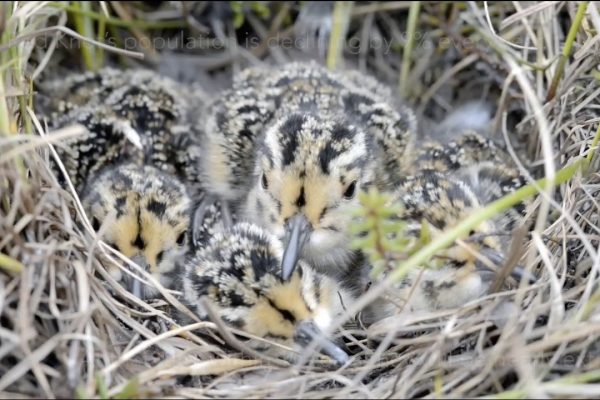-
OFFLU Network statement and guidance on HPAI H5N8
OIE/FAO Network of expertise on animal influenza (OFFLU) Situation Report and Guidance for H5N8 and other Eurasian H5 clade 2.3.4.4 Avian Influenza Viruses 29 November 2016 Wild birds play important roles in the circulation of avian influenza viruses and are reservoirs for low pathogenicity strains. In general, avian influenza viruses in wild birds can be […]
Continue reading -
Spoon-billed Sandpiper Conservation with the STA Sustainability Education Programme
Hiroshi Tomida, Manko Waterbird and Wetland Center, Japan Ewen Mcleish, St. Andrews International School Bangkok, Thailand Kiyomi Morita, St. Andrews International School Bangkok, Thailand Introduction As can be seen already, the number of migratory shorebirds is in rapid decline, posing a serious threat to biodiversity. Expanding coastal development has caused much damage. In addition, climate change will […]
Continue reading -
EAAFP pre-MOP9 meeting: Anatidae WG, Baer’s Pochard TF and Scaly-sided Merganser TF
A meeting focused on the Anatidae Working Group, Baer’s Pochard Task Force and Scaly-sided Merganser Task Force prior to the EAAFP MOP9 meeting in Singapore will be held on 10 January 2017. EAAFP pre-MOP9 meeting: Anatidae WG, Baer’s Pochard TF and Scaly-sided Merganser TF Date: 10 January 2017, 13:00 – 17:00 Venue: Tien Court, Copthorne King’s […]
Continue reading -
PTT 36 likes to be photographed
A note by Spike Millington, Chief Executive, EAAFP Secretariat, on the report from Global Flyway Network I know we are not supposed to ascribe human characteristics to animals, but I have a special feeling for Great Knots (maybe it’s the short legs and pot belly) and this amazing story from the Global Flyway Network of a […]
Continue reading -
The Economic Value of Wetlands (video)
Read in Chinese: 15 November 2016, The Paulson Institute China’s wetlands aren’t just about birds. As this short video shows, they have significant economic value, providing some $30 billion USD in ecosystem services to the millions of people who live in the country’s coastal regions. In other words, the wetlands not only provide habitat for migratory […]
Continue reading -
Why ET, HU or CT might lead us to missing spoonie sites
15 November 2016 Rebecca Lee, Saving the Spoon-billed Sandpiper With the third Spoon-billed Sandpiper on the move, Prof. Rhys Green gives us his insights on why these three birds could lead us to as yet unknown sites, and how that could have important implications for conservation efforts. From Prof. Rhys Green The journeys of the three tagged […]
Continue reading -
禽流感与野鸟科学工作小组针对 (2014年12月19日)
Read in other languages: 禽流感与野鸟科学工作小组针对 「家禽养殖场及野鸟发生 H5N8 高致病性禽流感」所发出的声明 2014年12月19日 由联合国迁徙物种公约(UN CMS)与联合国粮食及农业组织(FAO)联合召集的国际禽流感与野鸟工作小组发表的这份声明,主要是针对最近(自2014年11月起)出现的H5N8高致病性禽流感病毒。这份声明主要是针对H5N8高致病性禽流感病毒在野鸟与家禽之间潜在的关联,为政府部门及机构、家禽业、疾病控制、野生动物管理、位点管理及保护部门提供信息。 重点讯息 高致病性禽流感病毒(HPAI)的爆发大多情况下与高密度的家禽养殖及其相关的贸易及营销市场有关。 2014年家禽场养殖场多次爆发H5N8禽流感,首次爆发出现在韩国,之后相继出现在日本、中国、德国、荷兰、英国和意大利。这些禽流感事件大多发生在具有生物防护的家禽养殖系统中,但也有一些发生在野鸟中:野鸟可能被家禽感染,反之亦然。据报道,野鸟感染的情况发生在韩国、中国、德国、荷兰和美国。 通常情况下,高致病性禽流感病毒主要通过被感染的家禽,家禽产品和无生命的物体而传播,尽管期间野鸟可能也会起到了一定的作用。 由联合国迁徙物种公约(UN CMS)与联合国粮食及农业组织(FAO)联合召集的国际禽流感与野鸟工作小组促请各政府部门及机构: 进行全面的流行病学评估以确定病毒的真正来源 ,病毒通过国内及国际家禽贸易可能的传播途径,以及病毒在家禽与野鸟之间的传播机制; 无论感染源来自哪里,应先专注处理受影响的家禽养殖场的疾病防控工作,以尽量减低疾病蔓延至其它家禽养殖场及/或野生动物的风险,确保受影响的家禽养殖场与邻近地方实施生物防护,以防止野生动物与家禽接触; 确保疾病防控的措施不包含宰杀野鸟,或者破坏野生湿地的行为;以及 需留意的是,若公众注意力集中在野鸟身上,会令原本应集中用来处理疾病防控工作的力量错误地被分散,并将导致疾病在家禽中继续扩散,给农民及国家带来经济损失,并会对野鸟保护工作产生负面影响,及导致生物多样性的丧失。 当前情况 据媒体报道,2010年H5N8禽流感病毒在中国的家禽中被检测到。在2014年1月中旬,首例H5N8禽流感爆发是在韩国,众多的家养的鸡、鸭和鹅受影响。这种病毒又导致禽流感在日本(2014年4月)、中国(2014年9月)的家禽养殖场爆发,随后亦在德国、荷兰和英国(2014年11月)以及意大利(12月)的封闭和半封闭的家禽生产系统中爆发。 据报道,2014年年初在韩国多次爆发的禽流感事件中,一些野鸟因感染H5N8高致病性禽流感病毒而死亡,包括花脸鸭(Anas formosa) 和豆雁(Anser fabalis)。之后该病毒又在其它多个物种中被发现,包括骨顶鸡(Fulica atra)、 小天鹅 (Cygnus columbianus)、 白额雁 (Anser albifrons)、 绿头鸭 (Anas platyrhynchos)、 绿翅鸭 (Anas crecca) and 中国斑嘴鸭 (Anas zonorhyncha)。2014年11月在日本,该病毒又在两只小天鹅的粪便样品中被发现。欧洲首次在野鸟中检测到病毒是在11月16日被射杀的绿翅鸭中,距离11月6日的禽流感爆发地点大约50km。之后在12月1日,荷兰报道在两只赤颈鸭(Anas penelope)的粪便样中检测到该病毒。12月16日,美国报道,在华盛顿州与加拿大交界的附近位点在圈养的海东青(Falco rusticolus)中发现H5N8病毒,据称事发地点有给野鸟投食的情况。此外,同样在这个区域,一只针尾鸭(Anas acuta)曾被报道感染有H5N2高致病性病毒。 野鸟在H5N8禽流感病毒中的作用 在2010年中国报道在家禽中发现这种病毒之前,全球众多的野鸟监察小组并未在野鸟中检测到禽流感病毒的该种分株。以此推测,这种病毒首先起源于家禽中,之后可能传播到野鸟,再之后又从野鸟传回到家禽,期间的传播过程也有一些典型的人为传播途径的介入。尽管这个机制目前只是推测,但这种机制在H5N1高致病性禽流感病毒是存在的。 研究人员正尝试找出引起H5N8禽流感在欧洲爆发的病毒来源。部分人士猜测此病毒是由野鸟从东亚散播而来。首先值得注意的是,野鸟从东亚(例如中国或者韩国)直接迁徙到欧洲的情况鲜有发生。鸟类通常是作“南-北”迁徙(临近的迁徙路线在维度较高的区域会有“重叠”),并且在亚洲东北部繁殖的水鸟通常向南迁徙到东亚和东南亚,而不是到欧洲。野鸟在这么短的时间内将病毒从东亚带到西欧是非常异乎寻常的,特别是鉴于在这期间并没有极端天气的出现。 如果是在更长的时间框架内和在繁殖季节的话,禽流感病毒在邻近物种或者邻近迁徙路线之间传播,从而将并病毒向西部扩散的可能性是存在的。在这种情况,并且如果这种病毒在野鸟中广泛传播的条件下,即使在鸟类监测数据缺少的区域,我们也会预期这种禽流感病毒早已在欧亚大陆大范围爆发了。但事实是至今为止,这种情况并没有被报道。无论病毒起先是怎么传入的,人为的介入可能将病毒扩散到了全球的其它区域,包括之后扩散到了野鸟中。 H5N8与人类健康 与H5N1高致病性禽流感病毒不同,H5N8目前还没有显示可以感染人类的迹象。尽管仍需采取适当的卫生防护措施,但基于当前的认识,这种病毒对公众健康的危害系数较低。 […]
Continue reading -
조류 인플루엔자 및 야생조류 학술대책위원회 성명문 (2014년 12월 19일)
Read in other languages: 조류 인플루엔자 및 야생조류 학술대책위원회 성명문: 가금류 및 야생조류에서의 고병원성 조류 인플루엔자(HPAI) H5N8에 대하여 2014년 12월 19일 본 성명문은 국제연합(UN)의 이동성 야생동물 보호협약(CMS) 및 국제식량농업기구(FAO)가 함께하는 조류 인플루엔자 및 야생조류 학술대책위원회에서 발행하였다. 본 성명문은 최근 (2014년 11월부터 시작된) H5N8 HPAI 발생에 대응하여, 각 정부, 양계산업, 방제, 야생동물관리, 지역 관리와 보전분야의 이해당사자들에게 […]
Continue reading -
Saving the Red Knot (video)
Read in Chinese: The Paulson Institute The Red Knot flies each fall along two crisis-ridden migratory routes. One is the East Asia-Australasia Flyway, where many stops along the way have been damaged due to reclamation and other human activities. The other route, across the United States to a winter destination in Tierra del Fuego at […]
Continue reading -
The Miracle of Migratory Shorebirds (video)
Read in Chinese: The Paulson Institute The miracle of migratory shore birds is still not entirely understood by scientists. The Bar-tailed Godwit travels all the way from Alaska to New Zealand without stopping! If migratory birds have good tailwinds, they sometimes can fly as fast as 60 miles an hour! How and why do birds […]
Continue reading


